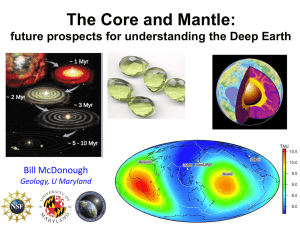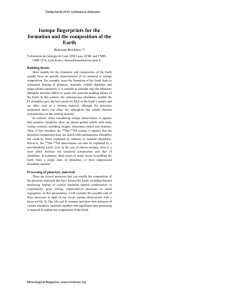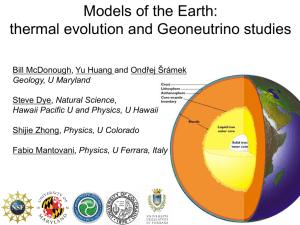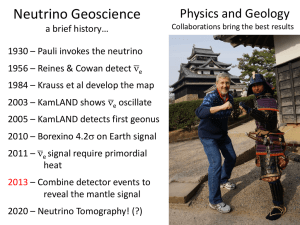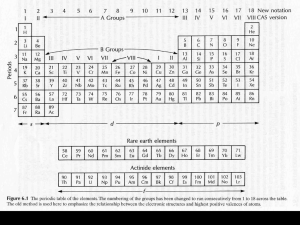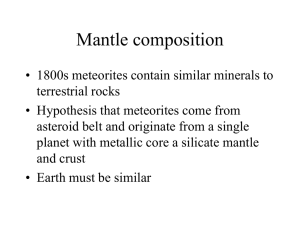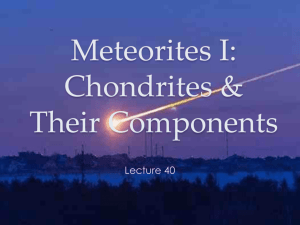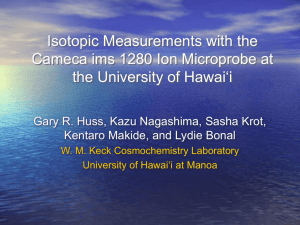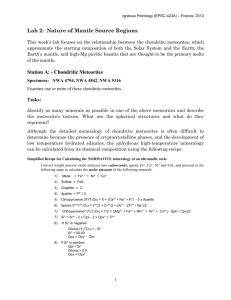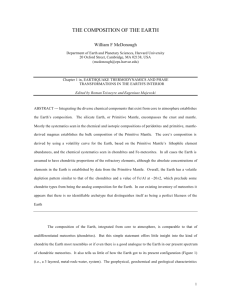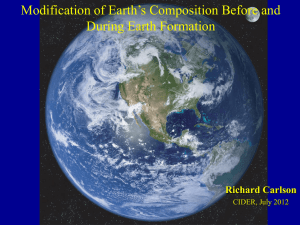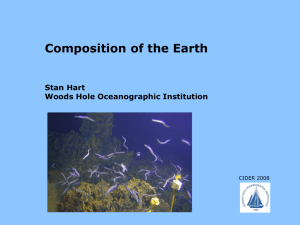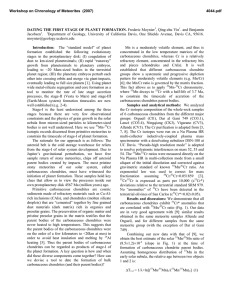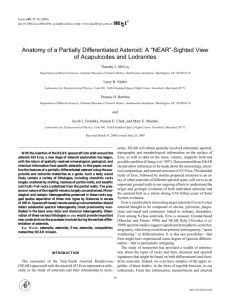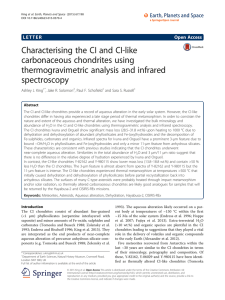Geothermal Studies on Earth`s Mantle and Crust
advertisement
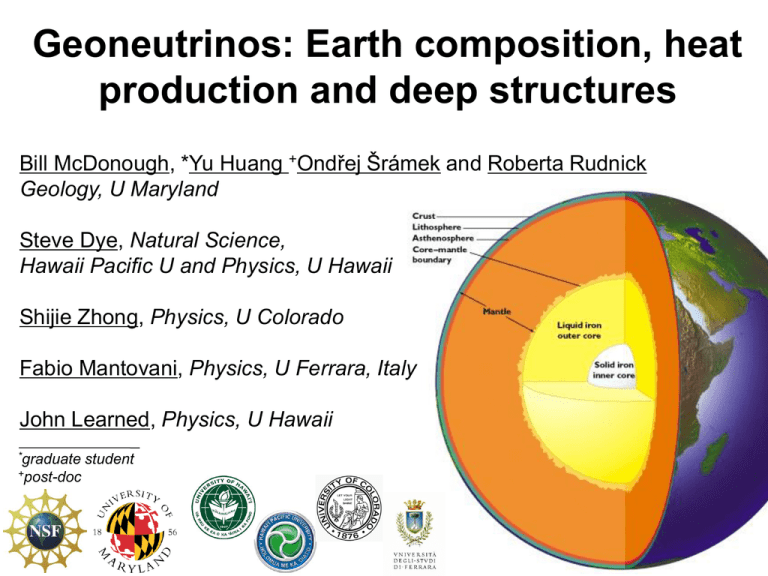
Geoneutrinos: Earth composition, heat production and deep structures Bill McDonough, *Yu Huang +Ondřej Šrámek and Roberta Rudnick Geology, U Maryland Steve Dye, Natural Science, Hawaii Pacific U and Physics, U Hawaii Shijie Zhong, Physics, U Colorado Fabio Mantovani, Physics, U Ferrara, Italy John Learned, Physics, U Hawaii *graduate +post-doc student Plate Tectonics, Convection, Geodynamo Does heat from radioactive decay drive the Earth’s engine? Nature & amount of Earth’s thermal power radiogenic heating vs secular cooling - abundance of heat producing elements (K, Th, U) in estimates of BSE from 9TW to 36TW the Earth - clues to planet formation processes constrains chondritic Earth models - amount of radiogenic power to drive mantle convection & plate tectonics estimates of mantle 1.3TW to 28TW - is the mantle compositionally layered? or has large layers, LLSVP, superplume piles structures? the future is… Geoneutrino studies Earth’s surface heat flow 46 ± 3 (47 ± 1) TW Mantle cooling (18 TW) Crust R* (7 ± 1 TW) (Rudnick and Gao ’03 Huang et al ‘13) Core (~9 TW) Mantle R* (13 ± 4 TW) - (4-15 TW) total R* 20 ± 4 *R radiogenic heat (after McDonough & Sun ’95) after Jaupart et al 2008 Treatise of Geophysics (0.4 TW) Tidal dissipation Chemical differentiation Arevalo, McDonough, Luong (2009) EPSL Archean boundary Power (TW) Earth’s thermal evolution: role of K, Th & U What is the composition of the Earth? and where did this stuff come from? Heterogeneous mixtures of components with different formation temperatures and conditions Planet: mix of metal, silicate, volatiles Sun and Chondrites are related Meteorite: Fall statistics (n=1101) (back to ~980 AD) Stony Iron meteorites Iron meteorites Achondrites Carbonaceous ~9% Chondrites ~4% Enstatite Chondrites ~2% Ordinary Chondrites 80% Most studied meteorites fell to the Earth ≤0.5 Ma ago Th & U K from McDonough & Sun, 1995 U in the Earth: ~13 ng/g U in the Earth “Differentiation” Metallic sphere (core) <<<1 ng/g U Silicate sphere 20* ng/g U *O’Neill & Palme (2008) 10 ng/g *Turcotte & Schubert (2002) 31 ng/g Continental Crust 1300 ng/g U Mantle ~12 ng/g U Chromatographic separation Mantle melting & crust formation Disagreement with chondritic Earth Models Murakami et al (May - 2012, Nature): “…the lower mantle is enriched in silicon … consistent with the [CI] chondritic Earth model.” Campbell and O’Neill (March - 2012, Nature): “Evidence against a chondritic Earth” Zhang et al (March - 2012, Nature Geoscience): The Ti isotopic composition of the Earth and Moon overlaps that of enstatite chondrites. Fitoussi and Bourdon (March - 2012, Science): “Si isotopes support the conclusion that Earth was not built solely from enstatite chondrites.” Warren (Nov - 2011, EPSL): “Among known chondrite groups, EH yields a relatively close fit to the stable-isotopic composition of Earth.” - Compositional models differ widely, implying a factor of three difference in the U & Th abundances of the Earth b - decay process (e.g., U, Th, K, Re, Lu, Rb) up quark down quark electron anti-neutrino 238 Terrestrial Antineutrinos U νe + p+ →n+ 232 e+ Th 1.8 MeV Energy Threshold 1α, 1β 234 Pa 1α, 1β νe 238U 232Th 2.3 MeV 40K νe 2.1 MeV 5α, 2β Bi 4α, 2β νe νe 3.3 MeV 2.3 MeV 46% 2α, 3β 206 Pb Ac 1% 31% 214 228 212 Bi 20% 40 K 1β 40 Ca Efforts to detect K geonus underway Terrestrial antineutrinos from uranium and thorium are detectable 1α, 1β 208 Pb Data improve with more counting TW scales with U concentration; 10, 20, 30 TW ≈ 10, 20, 30 ppb U in BSE Geoneutrino Flux on Earth Surface Activity and number of produced geoneutrinos i Ai n i P e e ( E , L ) V Volume of source unit ai ( L ) i ( L ) 4 L 2 dV Survival probability function Abundance and density of the source unit Distance between source unit and detector Earth structure ( and L) and chemical composition (a) Constructing a 3-D reference model Earth assigning chemical and physical states to Earth voxels 1o x 1o x “z” tile mapping of elements Huang et al (2013) G-cubed arXiv:1301.0365 Huang et al (2013) G-cubed Global Earth Reference Model - 7 layers for the top 200 km - Integrate 3 global models for the crust - New crust model with uncertainties Estimating the geoneutrino flux at SNO+ - Geology - Geophysics seismic x-section Global to Regional Model using only global inputs SNO+ Sudbury Canada improving our flux models adding the regional geology Predicted Global geoneutrino flux based on our new Reference Model Huang et al (2013) G-cubed arXiv:1301.0365 SUMMARY Earth’s radiogenic (Th & U) power 22 ± 12 TW or 11.2+- 7.9 5.1 TW Prediction: models range from 8 to 28 TW (for Th & U) On-line and next generation experiments: - SNO+ online 2013/14 - JUNO (Daya Bay II): good experiment, limited geonu application? - Hanohano: this is FUNDAMENTAL for geosciences Geology must participate & contribute to the cost Future: - Neutrino Tomography of the Earth’s deep interior
